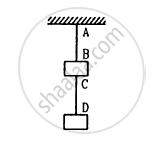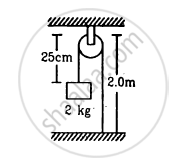Advertisements
Advertisements
Question
A steel wire of mass 4⋅0 g and length 80 cm is fixed at the two ends. The tension in the wire is 50 N. Find the frequency and wavelength of the fourth harmonic of the fundamental.
Solution
Given:
Mass of the steel wire = 4.0 g
Length of the steel wire = 80 cm = 0.80 m
Tension in the wire = 50 N
Linear mass density (m)
\[= \left( \frac{4}{80} \right) g/cm = 0 . 005 kg/m\]
\[\text{ Wave speed, } \nu = \sqrt{\left( \frac{T}{m} \right)}\]
\[ = \sqrt{\left( \frac{50}{0 . 005} \right)} = 100 m/s\]
\[\text{ Fundamental frequency ,} f_o = \frac{1}{2L}\sqrt{\left( \frac{T}{m} \right)}\]
\[ = \frac{1}{2 \times 0 . 8} \times \sqrt{\left( \frac{50}{0 . 005} \right)}\]
\[ = \frac{100}{2 \times 0 . 8} = 62 . 5 Hz\]
\[\text { First harmonic = 62 . 5 Hz }\]
If f_4 =frequency of the fourth harmonic:
\[ \Rightarrow f_4 = 4 f_0 = 62 . 5 \times 4\]
\[ \Rightarrow f_4 = 250 Hz\]
\[\text{ Wavelength of thefourth harmonic,} \lambda_4 = \frac{\nu}{f_4} = \frac{100}{250}\]
\[ \Rightarrow \lambda_4 = 0 . 4 m = 40 cm\]
APPEARS IN
RELATED QUESTIONS
When longitudinal wave is incident at the boundary of denser medium, then............................
- compression reflects as a compression.
- compression reflects as a rarefaction.
- rarefaction reflects as a compression.
- longitudinal wave reflects as transverse wave.
Explain why (or how): Bats can ascertain distances, directions, nature, and sizes of the obstacles without any “eyes”,
A transverse wave is produced on a stretched string 0.9 m long and fixed at its ends. Find the speed of the transverse wave, when the string vibrates while emitting the second overtone of frequency 324 Hz.
Explain the reflection of transverse and longitudinal waves from a denser medium and a rared medium.
You are walking along a seashore and a mild wind is blowing. Is the motion of air a wave motion?
A transverse wave travels along the Z-axis. The particles of the medium must move
Longitudinal waves cannot
A wave moving in a gas
A particle on a stretched string supporting a travelling wave, takes 5⋅0 ms to move from its mean position to the extreme position. The distance between two consecutive particles, which are at their mean positions, is 2⋅0 cm. Find the frequency, the wavelength and the wave speed.
Two wires of different densities but same area of cross section are soldered together at one end and are stretched to a tension T. The velocity of a transverse wave in the first wire is double of that in the second wire. Find the ratio of the density of the first wire to that of the second wire.
Two blocks each having a mass of 3⋅2 kg are connected by a wire CD and the system is suspended from the ceiling by another wire AB (See following figure). The linear mass density of the wire AB is 10 g m−1 and that of CD is 8 g m−1. Find the speed of a transverse wave pulse produced in AB and CD.

An organ pipe, open at both ends, contains
In the arrangement shown in figure , the string has a mass of 4⋅5 g. How much time will it take for a transverse disturbance produced at the floor to reach the pulley? Take g = 10 m s−2.

A circular loop of string rotates about its axis on a frictionless horizontal place at a uniform rate so that the tangential speed of any particle of the string is ν. If a small transverse disturbance is produced at a point of the loop, with what speed (relative to the string) will this disturbance travel on the string?
A tuning fork of frequency 440 Hz is attached to a long string of linear mass density 0⋅01 kg m−1 kept under a tension of 49 N. The fork produces transverse waves of amplitude 0⋅50 mm on the string. (a) Find the wave speed and the wavelength of the waves. (b) Find the maximum speed and acceleration of a particle of the string. (c) At what average rate is the tuning fork transmitting energy to the string?
A 660 Hz tuning fork sets up vibration in a string clamped at both ends. The wave speed for a transverse wave on this string is 220 m s−1 and the string vibrates in three loops. (a) Find the length of the string. (b) If the maximum amplitude of a particle is 0⋅5 cm, write a suitable equation describing the motion.
Three resonant frequencies of a string are 90, 150 and 210 Hz. (a) Find the highest possible fundamental frequency of vibration of this string. (b) Which harmonics of the fundamental are the given frequencies? (c) Which overtones are these frequencies? (d) If the length of the string is 80 cm, what would be the speed of a transverse wave on this string?
The phenomenon of beats can take place
Given below are some functions of x and t to represent the displacement (transverse or longitudinal) of an elastic wave. State which of these represent (i) a traveling wave, (ii) a stationary wave or (iii) none at all:
y = 3 sin (5x – 0.5t) + 4 cos (5x – 0.5t)
